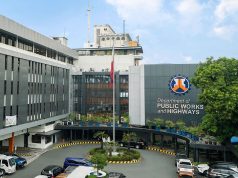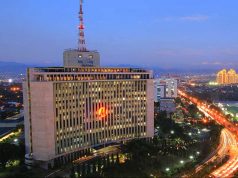Metro Manila lockdown extended
By Gillian M. Cortez and Jenina P. Ibañez
Reporters
THE government is keeping Metro Manila and two other areas under lockdown until the end of May, although some businesses will be allowed to resume partial operations.
Presidential Spokesperson Harry L. Roque said the modified enhanced community quarantine (ECQ) will be implemented in the National Capital Region, Laguna province and Cebu City from May 16 to 31.
In a televised briefing, Mr. Roque admitted the lockdown had a big impact on curbing the number of coronavirus disease 2019 (COVID-19) cases, but hurt the economy.
“Limitado ang government resources kaya kinakailangan natin na mag-generate ng resources para sa pang matagalang laban sa COVID… Sa hinaharap, kung walang economic interventions, ang mga kakalabasan ay mas makakadulot ng pinsala kaysa sa epekto ng COVID (Government resources are limited so we need to generate resources in the long-term fight against COVID… In the future, without economic interventions, the result would be worse than the effects of COVID),” Mr. Roque said in a televised briefing.
Metro Manila continues to be the epicenter of the country’s COVID-19 outbreak, accounting for more than half of the over 11,000 cases.
As of Tuesday, total deaths from COVID-19 reached 751, while confirmed infections stood at 11,350 and recoveries at 2,106.
Under a modified ECQ, selected manufacturing and processing plants will be allowed to operate with up to 50% of their workforce. Mr. Roque said the list of specific industries that will be allowed to operate will be released on Wednesday.
“Bubuksan natin unti-unti ang ating ekonomiya (We are gradually opening our economy),” he said.
Movement of people under the modified ECQ will be limited to work and obtaining essential services within the area. Limited transportation is also allowed for essential services and goods, while physical classes at schools remain suspended.
In mid-March, the government placed Luzon, which accounts for over 70% of GDP, under an ECQ that halted nearly all economic activity and domestic consumption.
GDP contracted by 0.2% in the first quarter, ending 21 years of uninterrupted growth. The Philippine economy is facing a recession as the second quarter is expected to be worse.
In a taped address aired on Tuesday morning, National Task Force COVID-19 chief implementer Carlito G. Galvez, Jr. said the Philippine economy cannot handle another total lockdown.
“The government, however, cannot endure the ECQ for an extended period of time as its resources are very limited. Hence, it has to balance between health and economy,” Mr. Galvez said.
The government also announced that eight “low-risk” regions will no longer be under community quarantine starting May 16. These include: Region 1 (Ilocos Norte, Ilocos Sur, La Union, Pangasinan,and Dagupan City); Region 4-B (Marinduque, Occidental Mindoro, Oriental Mindoro, Romblon, Palawan, and Puerto Princesa City); Region 5 (Albay, Camarines Norte, Camarines Sur, Catanduanes, Masbate, Sorsogon, Legazpi City, and Naga City); Region 6 (Aklan, Antique, Capiz, Guimaras, Iloilo, Negros Occidental, Iloilo City, and Bacolod City); Region 8 (Biliran, Eastern Samar, Leyte, Northern Samar, Western Samar, Southern Leyte, Ormoc City and Tacloban City); Region 10 (Bukidnon, Camiguin, Lanao Del Norte, Misamis Occidental, Misamis Oriental, Cagayan De Oro City); Region 12 (North Cotabato, South Cotabato, Sarangani, Sultan Kudarat, General Santos City) and BARMM (Basilan, Lanao Del Sur, Maguindanao, Sulu, Tawi-Tawi, Cotabato City).
Another eight “moderate-risk” regions were placed under a general community quarantine until May 31. These include: Cordillera Administrative Region (Abra, Apayao, Benguet, Ifugao, Kalinga, Mountain Province, Baguio City); Region 2 (Batanes, Cagayan, Isabela, Nueva Vizcaya, Quirino, Santiago City); Region 3 (Aurora, Bataan, Bulacan, Nueva Ecija, Pampanga, Tarlac, Zambales, Angeles City, Olongapo City); Region 4-A (Cavite, Quezon, Rizal, Batangas, Lucena City); Region 7 (Bohol, Cebu Province, Negros Oriental, Siquijor, Mandaue City, Lapu-Lapu City); Region 9 (Zamboanga Del Norte, Zamboanga Del Sur, Zamboanga Sibugay, Zamboanga City, Isabela City); Region 11 (Davao City, Davao De Oro, Davao Del Norte, Davao Del Sur, Davao Occidental, Davao Oriental); and Region 13 (Agusan Del Norte, Agusan Del Sur, Dinagat Island, Surigao Del Norte, Surigao Del Sur and Butuan City).
Finance Secretary Carlos G. Dominguez III stressed the need to ramp up the “Build, Build, Build” program to boost domestic consumption and stimulate the economy.
In a taped briefing, Mr. Dominguez also proposed the mass hiring of contact tracers to help the government’s efforts to curb the local transmission of COVID-19. This after the government reported around 1.2 million to 1.5 million Filipinos lost their jobs temporarily during the ECQ.
“We need to hire enough contact tracers to match the numbers we expect that will come with more testing,” he said.
MASS TESTING NOW
Business groups welcomed the government’s move to ease lockdown measures, but said there needs to be improvements in mass testing for the COVID-19 virus.
Employers Confederation of the Philippines President (ECoP) President Sergio R. Ortiz-Luis, Jr. in a phone interview said the modified lockdown means more people will be able to go to work, but “the problem there is I don’t know how they will implement.”
Mr. Ortiz-Luis urged the government to be more efficient in issuing passes and ensure transportation for workers. He expressed concern that the restrictions in movement would mean companies will prioritize hiring for workers who live close to or are able to go to the office.
“Pagbutihin ’yung testing nila. Pagbutihin ’yung putting up quarantine centers. Para slowly makasama ’yung mga tao sa first wave ng work (Improve their testing. Improve putting up quarantine centers, so that slowly people can join the first wave of work),” he said.
Pending further study of the decision and consultation with members, Joint Foreign Chambers of Commerce of the Philippines (JFC) Senior Adviser John Forbes said they are ready for more relaxed rules to enable economic recovery to start.
“But the low level of testing and tracing gives us pause about the risks of ending the lockdown,” he said in a mobile message on Tuesday.
Trade Secretary Ramon M. Lopez said “low risk and high economic impact in terms of jobs” will be allowed to operate during the modified ECQ.
In a message to reporters, he said these industries include construction and labor intensive manufacturing services.
“(Reopening) will be done in phases, while in modified ECQ. As they transition to GCQ (general community quarantine),” he said.
“Those products just for deliveries under ECQ, because of the nature and number of retail store operations, are examples of items that may be gradually opened in the transition.”
Previously, only critical industries such as food preparation, banks, utilities, supermarkets, logistics, and health companies were allowed to operate under ECQ. Outsourcing and export industries were allowed to have some operations, as long as companies provided transportation and accommodations.



